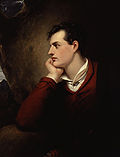She Walks in Beauty: Difference between revisions
SapientSquid (talk | contribs) mNo edit summary |
added text of the poem Tags: Reverted Visual edit |
||
| Line 37: | Line 37: | ||
==Musical settings== |
==Musical settings== |
||
The poem has inspired various composers over time, including [[Roger Quilter]], [[Gerald Finzi]], [[Toby Hession]], [[Ivy Frances Klein]], [[Jean Coulthard]], [[Isaac Nathan]], [[Nicolas Flagello]], [[Mychael Danna]], and [[Sally Whitwell]]. The British musical ensemble [[Mediaeval Baebes]] sing the complete poem on their 2015 album ''The Huntress''. |
The poem has inspired various composers over time, including [[Roger Quilter]], [[Gerald Finzi]], [[Toby Hession]], [[Ivy Frances Klein]], [[Jean Coulthard]], [[Isaac Nathan]], [[Nicolas Flagello]], [[Mychael Danna]], and [[Sally Whitwell]]. The British musical ensemble [[Mediaeval Baebes]] sing the complete poem on their 2015 album ''The Huntress''. |
||
== Text == |
|||
She walks in beauty, like the night |
|||
Of cloudless climes and starry skies; |
|||
And all that’s best of dark and bright |
|||
Meet in her aspect and her eyes; |
|||
Thus mellowed to that tender light |
|||
Which heaven to gaudy day denies. |
|||
One shade the more, one ray the less, |
|||
Had half impaired the nameless grace |
|||
Which waves in every raven tress, |
|||
Or softly lightens o’er her face; |
|||
Where thoughts serenely sweet express, |
|||
How pure, how dear their dwelling-place. |
|||
And on that cheek, and o’er that brow, |
|||
So soft, so calm, yet eloquent, |
|||
The smiles that win, the tints that glow, |
|||
But tell of days in goodness spent, |
|||
A mind at peace with all below, |
|||
A heart whose love is innocent! <ref>{{Cite web |last=Foundation |first=Poetry |date=2024-06-27 |title=She Walks in Beauty by Lord Byron (George Gordon) |url=https://www.poetryfoundation.org/poems/43844/she-walks-in-beauty |access-date=2024-06-28 |website=Poetry Foundation |language=en}}</ref> |
|||
== References == |
== References == |
||
Revision as of 14:41, 28 June 2024

She walks in beauty, like the night
Of cloudless climes and starry skies;
And all that's best of dark and bright
Meet in her aspect and her eyes
Thus mellow'd to that tender light
Which heaven to gaudy day denies.
One shade the more, one ray the less,
Had half impair'd the nameless grace
Which waves in every raven tress,
Or softly lightens o'er her face;
Where thoughts serenely sweet express
How pure, how dear their dwelling-place.
And on that cheek, and o'er that brow,
So soft, so calm, yet eloquent,
The smiles that win, the tints that glow,
But tell of days in goodness spent,
A mind at peace with all below,
A heart whose love is innocent![1]
"She Walks in Beauty" is a short lyrical poem in iambic tetrameter written in 1814 by Lord Byron, and is one of his most famous works.[2]
It is said to have been inspired by an event in Byron's life. On 11 June 1814, Byron attended a party in London. Among the guests was Mrs. Anne Beatrix Wilmot, wife of Byron's first cousin, Sir Robert Wilmot. He was struck by her unusual beauty, and the next morning the poem was written.[3]
It is thought that she was the first inspiration for his unfinished epic poem about Goethe, a personal hero of his. In this unpublished work, which Byron referred to in his letters as his magnum opus, he switches the gender of Goethe and gives him the same description of his cousin.[citation needed]
Musical settings
The poem has inspired various composers over time, including Roger Quilter, Gerald Finzi, Toby Hession, Ivy Frances Klein, Jean Coulthard, Isaac Nathan, Nicolas Flagello, Mychael Danna, and Sally Whitwell. The British musical ensemble Mediaeval Baebes sing the complete poem on their 2015 album The Huntress.
Text
She walks in beauty, like the night
Of cloudless climes and starry skies;
And all that’s best of dark and bright
Meet in her aspect and her eyes;
Thus mellowed to that tender light
Which heaven to gaudy day denies.
One shade the more, one ray the less,
Had half impaired the nameless grace
Which waves in every raven tress,
Or softly lightens o’er her face;
Where thoughts serenely sweet express,
How pure, how dear their dwelling-place.
And on that cheek, and o’er that brow,
So soft, so calm, yet eloquent,
The smiles that win, the tints that glow,
But tell of days in goodness spent,
A mind at peace with all below,
A heart whose love is innocent! [4]
References
- ^ Byron, George Gordon, Lord (1905). The Complete Poetical Works (Cambridge ed.). Boston: Houghton Mifflin. p. 216.
{{cite book}}: CS1 maint: multiple names: authors list (link) - ^ OED."She Walks in Beauty" Retrieved 3 january 2020
- ^ Cummings, Michael J. (2008) "Byron's She Walks in Beauty" at Cummings Study Guides. Retrieved 10 July 2014
- ^ Foundation, Poetry (27 June 2024). "She Walks in Beauty by Lord Byron (George Gordon)". Poetry Foundation. Retrieved 28 June 2024.
External links
Works related to She walks in beauty at Wikisource
